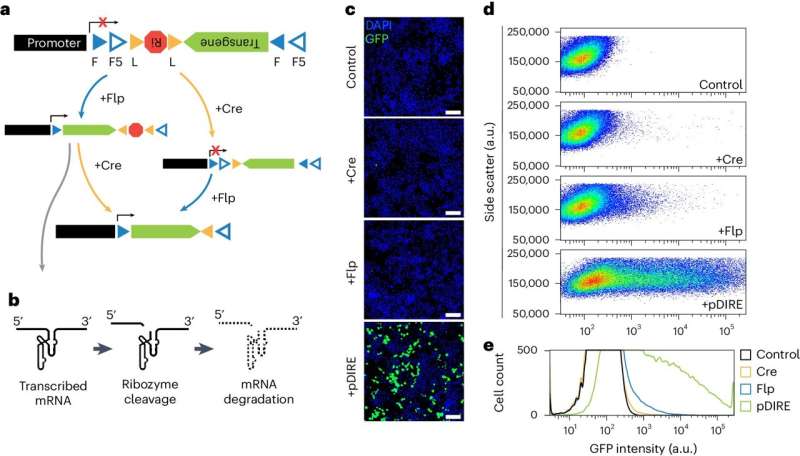May 27, 2024
Editors’ notes
This article has been reviewed according to Science X’s
editorial process
and policies.
Editors have highlighted
the following attributes while ensuring the content’s credibility:
fact-checked
peer-reviewed publication
trusted source
proofread

As gene sequencing technologies become more powerful, our understanding of cellular diversity has grown in parallel. This led scientists at St. Jude Children’s Research Hospital to create a tool to improve the ease and accuracy with which investigators can study specific subpopulations of cells.
The tool, named Conditional Viral Expression by Ribozyme Guided Degradation (ConVERGD), allows researchers to specifically access these subgroups of cells and precisely manipulate them based on multiple features of the cell.
ConVERGD offers numerous advantages over existing intersectional expression platforms by accommodating more complex genetic payloads and increased adaptability. The researchers demonstrated the utility of ConVERGD by studying a previously unidentified subpopulation of norepinephrine neurons.
The work demonstrates the substantial impact that investigations into cellular subpopulations could have on fundamental research and health care. The findings were published today (May 27) in Nature Neuroscience.
Same type of cells, different functions
For Lindsay Schwarz, Ph.D., St. Jude Department of Developmental Neurobiology, necessity drove invention as she explored the neuronal cell landscape, and in particular, neuronal cells that produce norepinephrine.
“Norepinephrine neurons have been thought to be just one type of neuron. But when they’re activated in the brain, they can cause a lot of different types of behavior, such as enhancing attention and memory formation or eliciting a stress response or fight-or-flight response,” Schwarz said. “But if it’s only one type of neuron releasing this one molecule, then how does it make you do different things?”
To explore such questions requires the ability to selectively interrogate cellular subpopulations with extreme prejudice. To this end, Schwarz found all attempts using current practices were coming up short. “We didn’t go into this project thinking we would build a new tool, but it seemed like a need in the community.”
Improving on current cellular subpopulation targeting technology
Targeting subpopulations of cells requires passing them through several genetic filters. These intersectional filters interrogate what genes the cells express and what pathways and connections they make, parsing out the different subpopulations so that researchers can focus on a select group of isolated cells.
The use of adeno-associated virus (AAV)-based reporter tools which can deliver genetic material into specific cells with high precision is an ideal approach for applying these intersectional filters. These reporter tools are used to label or monitor gene expression and protein localization within specific cells or regions. However, they can be complex to design and offer a limited amount of space within them.
“One of our main goals was to design a tool where your gene of interest only got expressed when conveyed with multiple features but is really easy for end users to modify and put in whatever genes they want,” explained Schwarz.

Robust ribozymes offer next-generation specificity
Schwarz and first author Alex Hughes, Ph.D., a graduate of the St. Jude Graduate School of Biomedical Sciences, currently of the Allen Institute for Brain Science, leveraged two separate technologies in the design of ConVERGD, namely AAV-based reporter technology and inspiration from the world of ribozymes, strands of RNA that can behave like enzymes by catalyzing biochemical reactions.
Importantly, ribozymes can be engineered to control the on/off switch for gene expression with extreme precision. “We initially heard about ribozymes from a journal club that was thinking more therapeutically about how to use AAVs,” Schwarz said. “Alex came back and figured that he could come up with a way to utilize these in neuroscience tools.”
Exciting for the neuroscience community and beyond
As a proof-of-concept, Schwarz and Hughes used ConVERGD to interrogate a subpopulation of norepinephrine neurons. “Collectively, norepinephrine neurons do a lot of different things,” Schwarz explained. “The subset we were targeting makes norepinephrine, but they also make this other opioid peptide called dynorphin, which hasn’t been characterized in these neurons before. With ConVERGD, we found that activating just these dynorphin-expressing neurons was enough to elicit an anxiety response.”
By parsing out the functions and assigning them to a subpopulation of cells, Schwarz is hopeful that targeted therapy is a possibility. “We treat anxiety and depression with drugs that target norepinephrine signaling, but they target it globally,” Schwarz said. “You’re also going to see a detriment to other important functions for norepinephrine that you don’t want to see. Targeting these neurons more specifically could help to ameliorate that.”
The work will have ripple effects outside of St. Jude. “We’re really excited about this for the community,” Schwarz said. “ConVERGD should be amenable to any tissue. It could be useful beyond neuroscience.”
More information:
Alex C. Hughes et al, A single-vector intersectional AAV strategy for interrogating cellular diversity and brain function, Nature Neuroscience (2024). DOI: 10.1038/s41593-024-01659-7
St. Jude Children’s Research Hospital
Citation:
Cell-targeting technology can isolate neuronal subpopulations and link them to behavioral states (2024, May 27)
retrieved 27 May 2024
from https://medicalxpress.com/news/2024-05-cell-technology-isolate-neuronal-subpopulations.html
This document is subject to copyright. Apart from any fair dealing for the purpose of private study or research, no
part may be reproduced without the written permission. The content is provided for information purposes only.
Explore further
Scientists produce human norepinephrine neurons from stem cells
0 shares
Feedback to editors
